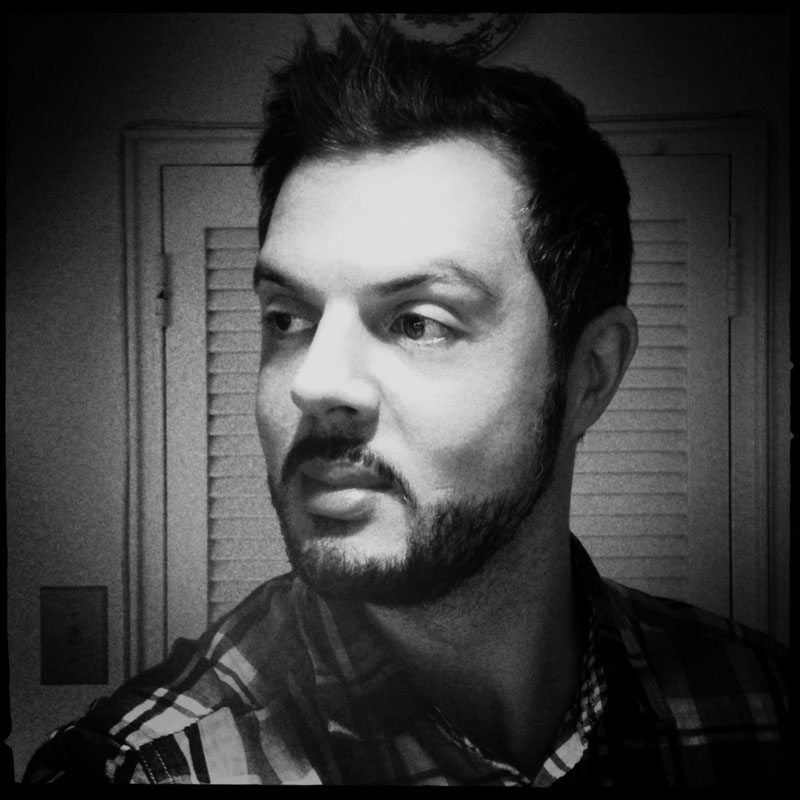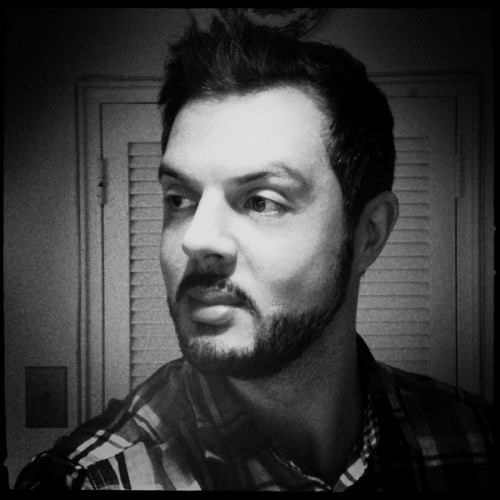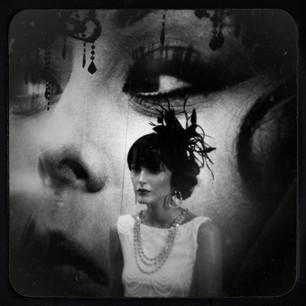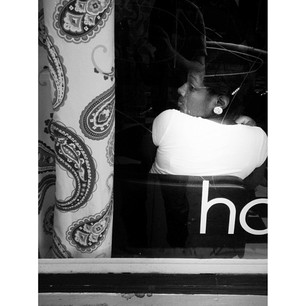Operating under the moniker Konstruktivist, Dan Cristea is one of the most prolific and original iPhoneographers around. Defying categorization or conventional rules of composition, his images convey a strong sense of artistic vision, as well as an affectionate eye for strange characters. Based in Toronto, Canada, he is a graphic designer as well as founding member of the Lofimode.com website, which he runs along with friend and fellow iPhoneographer Richard “Koci” Hernandez.
In the Life In LoFi interview, Dan shares his thoughts on life, his style, and his aesthetic approach to photography. This extensive interview is being presented in two parts. Click past the jump for part I. >>>
Life In LoFi: When or why did you decide to start taking pictures? Did someone draw you into it? And how has that relationship with photography evolved ever since?
Dan Cristea: For as long as I can remember, I’ve always had a fascination about the idea of what a camera can do. My father, who is an amateur photographer, is probably the main reason why I started taking pictures. I remember vividly even now taking his Zenith-E Special Olympics off his shoulder and running away to snap a picture of my parents while vacationing in Romania. I was about 9 or 10 years old at the time if my memory is correct. The idea of capturing a fragment of life on to a piece of paper with this mysterious big black box was something very fascinating to me. But more than anything, it was the honesty of the medium that truly fired up my enthusiasm. One of the major key elements that I’ve learned from him was to be spontaneous, to be alert at all times about my surroundings and sink in the moment when a situation is most “vulnerable” if I may say so. His candid approach to photography is something that I’ve carried with me ever since then.
LOFI: Would you care to share with us your influences? Mind you, these need not be necessarily restricted to photography.
 DC: Sure, my influences are a bit all over the place to be honest. I admire very much classic photographers such as; Henri Cartier-Bresson, Roy DeCarava, Louis Faurer, Andre Kertesz, William Eggleston, Fred Herzog, Vivian Maier and Keith Weaver the list can go on.
DC: Sure, my influences are a bit all over the place to be honest. I admire very much classic photographers such as; Henri Cartier-Bresson, Roy DeCarava, Louis Faurer, Andre Kertesz, William Eggleston, Fred Herzog, Vivian Maier and Keith Weaver the list can go on.
But if I would have to pinpoint one major influence I would have to be, Saul Leiter. His approach to photography is an invitation to the eye, to see what you normally wouldn’t see. He has a very suggestive style of shooting and that’s because he first started as a painter. Later on, when he moved into photography, he brought along with him, all the texturing and the feel of a painting, he’s absolutely mind-blowing. He was also one of the first street photographers to shoot in color throughout the 40’s and 50’s. A huge source of inspiration to me and I could never get enough of his work. I find myself flipping through his books at least once a week.
I also find inspiration in classic traditional paintings. I very much admire the work of John Singer Sargent for his incredible sense of light and composition, Phil Hale for his distinguished body language and staggering sense of hyperrealism. I find that the fact that I started to draw at a very early age, really affected a lot the way I see and look at things around me. However, that made me realize how important it is to understand light, shadows, composition, proportions and geometry. If you look at the work of John Singer Sargent for example, you quickly understand how every single element had a fundamental role. Every detail was thought out, nothing was compromised but rather celebrated, and I try to transpose that idea into my photography or digital collage as much as possible.
There is something very engrained in me about retro graphics & typography. When I was young living in Romania, we where very secluded from external visual imagery. What I mean by that is that since I was living in a communist regime, it was very difficult to be able to have your hands on a nice magazine or publications. Luckily for me, my father had a fantastic collection of 60’s and 70’s French and Italian magazines that if found myself flipping through almost on a daily basis without him knowing, of course…hehe! Artists such as Stefan Sagmeister and Mark Weaver have a profound influence on my graphic work. I find a tremendous sense of nostalgia that somehow draws me back to my childhood and brings a very strong sense of creative innocence.
LOFI: How often do you work on your iPhoneography?
DC: As often as possible. Whenever I find a gap of time, during commute or anytime I get bored. I try to kill the time by doing something creative rather occupy my mind with useless thought. Let’s put it this way; it’s my own salvation form the daily boredom.
LOFI: Do you spend as much time on editing your photos as you do on going out there and capturing them?
DC: I would say half and half. With time, I found myself shooting less because the more you shoot the more you know what you really are looking for. Henri Cartier-Bresson said “Your first 10 000 pictures are your worst” I find that to be very true. ?However, I think that it is very important to go thought this process of obsessive shoot, shoot, shoot!! Until you find your own personal style.
LOFI: What has been the some of the challenges of using the iPhone as a camera? As far as I’m aware, you’ve been using an iPhone 3G, which makes the creative risk even bigger, considering its limitations against the latest models. Or would you say that it eventually adds to your unique style?
DC: That’s a great question. I’ve always looked at the iPhone as a camera that I can make phone calls with, not the other way around. To me, the iPhone is that little brilliant and well-designed gadget that I’ve always dreamed to have when I was growing up. I remember when I first started talking to Koci about the incredible possibilities that this “camera” has to offer he said, “This is the darkroom in the palm of your hand!” The fact that I don’t have to sit in front of a computer all day long and I don’t have to lug a big camera over my shoulder really opened a new and exciting door of creative possibilities. In contrast with others, I find the restrains of this new medium extremely fresh and challenging, and forces me to think differently each time I create something.
As far as having the latest iPhone, it’s not something that I pay too much importance. They say that the best camera is the one you have on you. The new iPhone 4S sure is faster, better camera but my process of building an image is rather slow. More often than not, I would start working on something and then let it sit for a while, let it breath like a good wine that you just open. You want to let it breathe so it matures in the back of my head. Same thing when I shoot, I rarely snap something more than once. First because my camera is slower and I mainly shoot with Hipstamatic and second, it confuses the hell out of me… hehe. I rather have one good shot then ten bad ones. So in a way, it does limit me but at the same time I think that the tools you have defines the medium and eventually your style.
LOFI: You’re already responsible for a vast amount of work, but can you bring yourself to choose a single image that never fails to make you go “wow”? That makes worth all your while?
DC: No, and if I would I would stop doing this. I like to think that the best is yet to come, at least the idea of it. I’m never satisfied with what I do, but I guess that’s a good thing. It pushes me to go further and explore more.
LOFI: You met fellow mobile photographer, Richard “Koci” Hernandez, on Instagram. And ever since, you two have been sharing a friendship, you’ve been collaborating on photos and numerous projects. Want to tell us a little about Koci, the lofimode.com site you’ve founded together, the 1197.is convention that you’ve participated in and any of your future projects?
DC: It’s funny that you ask me this question since you are the one to have introduced me to Koci. I came on Instagram around January 2011, so that makes it just over a year ago now. And like many of us, I was very excited to have finally found a platform that was right on what I was looking for. It spoke to me right away and somehow I saw an incredible potential to meet creative like-minded people. When I first discovered the work of Richard Koci Hernandez, I felt like someone had pulled the carpet underneath my feet. For the first time on IG, I found myself going through someone’s feed entirely and being totally captivated by his unique vision and remarkable style. I knew that this man was something else, something very different and his work was sticking out like a sore thumb. So at the time I decided to approach him for some small fun collaboration between the two of us. The idea for lofimode.com came from the famous “How did you do that?” question on Instagram. Since Koci is already a professor at UC Berkeley School of journalism, I thought it could be cool to put together a website where we could share out “tips and tricks” on iPhoneography. So we decided to make some tutorials that we can share with those who are interested in this art form online. In the summer of 2011, Koci and I met for the first time in Montreal, Canada. We both connected right away and ended up walking the streets of Montreal for about two days consistently shooting and feeding off each other’s passion for photography. That ended up as a book that we decided to keep for us, as a memoir of our encounter. It was an experience I will never forget, a true mind opener.
The idea of a workshop came pretty much at the beginning of our friendship and took a lot of time and work before it materialized. We liked the idea of being able to share out thoughts and tips with the world, but we wanted to have a more direct approach. When the opportunity came for us to be part of 1197.is in San Francisco, we jumped to the occasion and put together a presentation in which the goal was not to perhaps teach, but to show the possibilities of the medium and the power of the iPhone.
As for some future projects, yes absolutely. We both have been very busy lately but the way things look right now, we have some nice updates coming up on LFM and hopefully a video tutorial from my end. As for other workshops, the future will tell.
…
Dimitris Karathanos’ interview of Dan Cristea concludes tomorrow in Part II.
~~~~






